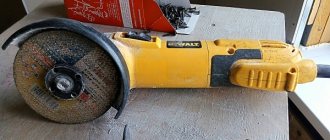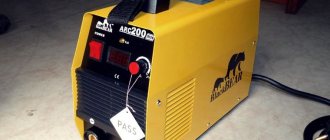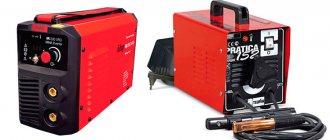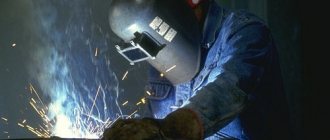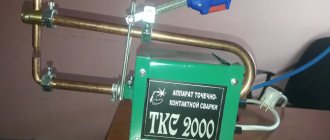Having a private house or cottage, from time to time you are faced with the need to weld something. It is expensive to pay a welder for services each time, especially since many jobs do not require special qualifications. Then there is a desire to purchase a welding machine and learn how to weld it yourself. The easiest way to learn welding is with inverter welding machines. They are controlled electronically, thanks to which they have several functions that make life much easier for a novice welder. These units allow you to get a high-quality seam even without much experience. Now it’s a small matter: you need to find out how to choose a welding inverter.
How to choose a welding inverter for your home or cottage if there are dozens of brands?
How to properly cook by welding, video instruction
Let’s say you just need a welding machine for housework, but you don’t know how to weld properly. The video material presented below will help you understand this process once and for all.
How to choose a good welding inverter
It consumes relatively a lot, around 5 kWh, and the product description provided by the supplier directly on the sales site shows that it does not come with a plug-in connector. It is already quite clear that only professionals know how and what to choose in the field of welding inverters, and if you count among hobbyists or semi-professional users, you will face great difficulties trying to find out where welding inverters are at a good price or decide which model is the most suitable for you.
But first, a little theory. To begin with, we list the items a worker needs for welding:
- 1. Protective mask.
- 2. Suede mittens.
- 3. Tools for removing slag.
- 4. Welding unit.
- 5. Electrode or special wire.
- 6. Protective suit.
To make a high-quality weld, the first step is to develop practical welding skills. Without a doubt, each subsequent seam you make will be better than the previous one, so it’s best to try your hand at simple surfaces first. An integral part of welding work is safety precautions; under no circumstances start work without gloves and a mask. The metal that you will weld must be thoroughly cleaned with sandpaper or a file, this is necessary so that ignition of the arc does not cause problems and the weld is neat, since dirt and rust interfere with this.
Whether you need to weld pipes, various parts, or work with this technique in metal sculpting, it is imperative to know what type of device is suitable for the task you propose. For everyday and long-term use, a classic welding machine is better, but if you want high mobility, sophisticated technology, low consumption, and you can use a household power source, then an inverter is the best solution. We've put together a short list of features that any quality model should be able to match, and depending on which one you can target to make your desired purchase.
Areas of use
Based on this comparison of the operation of devices with alternating and direct current, we can conclude that the transformer is suitable for periodic welding of non-critical structures made of low-carbon steels.
It is advisable that welding be carried out in the lower position. At the same time, the welder must have certain qualifications, otherwise the seams will be very bad. The transformer will “survive” in construction conditions, frequent transportation, and dusty rooms. This is the optimal brew for a summer house, garage, to save money. Video source: Vitaly M
But AC transformers can also be useful for professional applications. For example, when welding coated electrodes on aluminum or rusty metal that cannot be cleaned. They are better than inverters because constantly changing the direction of electron flow helps break down aluminum oxide or contaminants on the surface. Direct current is not capable of this (only in combination with a pulse)
Inverters are better for beginners to learn how to cook. It is easier to work with them in all spatial positions, as well as to weld:
Changing the polarity will help weld thin metal 1-2 mm without burns. But inverters require more careful care and careful handling, otherwise frequent breakdowns will be expensive.
For professional activities or a private workshop, it is better to buy AC/DC welding machines. By switching from alternating to direct current, you can weld any metal efficiently and enjoy the pleasant rustle of the electric arc.
About categories and prices
All inverter manual arc welding machines working with consumable electrodes, designated MMA, can be divided into two large groups:
- Household - for occasional use and simple work. If you are not planning a large-scale construction project, you will need the device once every two to three months to repair something, weld something, etc., then the working life of the units of this group is sufficient. These are the cheapest of the inverter welders. They cost 3-5 thousand rubles or so, produced in China.
- Professional - for long hours of daily work. This is an option for those who will use an inverter in production or are planning large-scale construction: build a dacha or house, weld a metal fence and stairs. The cost of these units is about $300-400.
There is also an intermediate class - semi-professional. In terms of characteristics and price, they are approximately in the middle. This is a good choice for those who love to make things and also love a good tool. All gradations are very arbitrary, but if you tell the seller what class you want the device to be, he will understand you and offer several options.
There are also universal or combined welding inverters. They can weld in several modes, one of which is usually manual arc welding. These units belong to the professional class and are convenient for their versatility - some can also work as a cutter, as well as cook in an environment of inert gases, which allows you to weld thin metal and stainless steel without any problems. This equipment will be useful if you also have a car - you can do repairs yourself, as well as cook all sorts of small things around the house.
DC and AC inverters
Device and difference
Let's look at the operating principle of an AC inverter
. The conversion of mains voltage into welding voltage occurs in the following sequence. First, it is rectified and fed to a converter, which generates a high-frequency pulse sequence. The main idea is to supply a 220 volt network voltage to the step-down transformer with a frequency of not 50 Hz, but 30 - 70 kHz.
In this case, the dimensions and weight of the transformer are significantly reduced. To help you imagine this colossal difference, let's give an example: a transformer with a power of about 5000 W, converting a voltage with a frequency of 50 Hz, will weigh about 20 kilograms. A transformer of the same power, but operating at a frequency of 50 kHz, will weigh 250 grams. What will you choose?
Next, the voltage reduced to 60 volts is supplied to the welding electrode from the output of the transformer.
DC inverter
for the most part repeats the circuit of an AC inverter. But a rectifier is added at the output, which converts the output AC voltage to DC.
What to choose
We have dealt with the differences in the design of these types of power sources for welding processes. But, by and large, for most users the power supply device is of little interest. More important for him is the purpose of the various sources and their areas of application. This will ultimately be decisive in your choice.
Try to choose a welding power source that can be connected to the existing network without the risk of overloading it. In addition, the purpose of the source must correspond to the work that you intend to perform with its help. To make the right choice, familiarize yourself with the features of welding various metals.
What wire should I use to weld thin metal?
They use welding wire
with a diameter of 0.8 - 1.6 mm.
Due to the fact that it has no coating, a shielding gas is supplied to the weld pool area (the area where the burning arc and molten metal
), which does not allow air oxygen to come into contact with the molten
metal
.
Interesting materials:
Why is central placenta previa dangerous? Why are antiperspirants dangerous? Why are rotten teeth dangerous? How to bleach colored bed linen? How to open a file with the FLAC extension? How to clean flux from a printed circuit board? How to grind buckwheat into flour? What does the king crab eat? Why is Python language bad? What's bad about synthetics?
Maximum electrode diameter
Essentially the same characteristic of the operating current range. Sometimes, due to illiteracy or malicious intent, the diameter of the electrode is indicated, which will not be able to cook with the stated maximum current. Sometimes it’s the other way around: the maximum diameter of the electrode is indicated, which clearly does not reach the value of the declared welding current.
The latter option is occasionally a glimpse into the conscience of deceptive suppliers. They indicate the short-circuit current as the maximum current. But the maximum working diameter of the electrode is still indicated honestly.
Duty cycle, also known as PV (on period), also known as PN (payload)
PV is indicated by two numbers. The first is current strength. The second is the percentage of time. For example, “130A-50%” means that this device with a current of 130A can cook half the time. And the same amount of time will remain idle, waiting for cooling to operating temperature. If measurements are carried out at the maximum current of the device, the first digit is omitted, leaving only the percentage indicator. For example, if a device with a rating of 160A has the entry “30%” opposite “PV”, this means that with a current of 160 amperes it can operate 30% of the time, and 70% will cool down.
That's right. It only remains to add that the domestic GOST R IEC 60974-1-2004 does not establish a single mandatory method for measuring the PN indicator for MMA devices.
“The standard does not apply to limited-duty manual arc welding power supplies that are designed primarily for use by non-professionals.”
The European methodology, set out in the EN60974-1 standard, suggests measuring on a load stand at an ambient temperature of 40C only until the first shutdown due to overheating. The result obtained is referred to a 10-minute period. It turns out that the thermal protection worked after 3 minutes, the cycle of the device at this current is 30%.
Methodology of the TELWIN concern. To date, it is used by most Chinese manufacturers (those that generally conduct such tests on their cars). The Italian concern itself, when measuring the PV of its devices using its own method, modestly indicates “TELWIN” after the indicator. The vast majority of Chinese manufacturers do not do this.
Finally, there is a Russian, also known as Soviet, methodology. In essence, it is closer to the TELWIN method: all intervals during the control period when the device was working are summed up. But the segment is taken not 10, but 5 minutes. And - most importantly - the device is first put into overheating protection mode, after which measurements begin.
As a result, the same device produces completely different percentages using all 3 methods! Naturally, the most modest “numbers” are obtained using the European method, and the most impressive ones – up to 2 times or more – using the Telwin method.
Advantages and disadvantages
The main advantages of such devices are as follows:
- the ability to reduce the supply voltage to 135 volts;
- ensuring stable arc power during large amplitude throws;
- compensation of losses when connecting through long extension cords.
There are also disadvantages:
- at reduced voltage you have to work on thinner electrodes or wire;
- the thickness of the workpieces to be welded is also limited;
- the cost of such a device is a quarter higher than a regular one (with equal power and general functionality).
If we compare the main advantages and disadvantages inherent in low-voltage inverter welding machines, the scope of their application becomes obvious. This:
- remote areas with low quality power supply;
- the need to operate from a household electric generator;
- connection via extension cords from 50 meters.
The devices will allow you to make seams of good quality even in such difficult conditions.
[my_custom_ad_shortcode2]
Elements of the electrical circuit of inverter devices
The welding inverter device consists of the following basic elements:
- rectifier for alternating current coming from a regular electrical network;
- an inverter unit assembled on the basis of high-frequency transistors (such a unit is a generator of high-frequency pulses);
- a transformer that lowers the high-frequency voltage and increases the high-frequency current;
- high-frequency alternating current rectifier;
- working shunt;
- electronic unit responsible for controlling the inverter.
Whatever characteristics a particular model of inverter device has, the principle of its operation, based on the use of a high-frequency pulse converter, remains unchanged.
Example of an inverter circuit diagram (click to enlarge)
The rectifier and inverter units of the equipment become very hot during their operation, so they are installed on radiators that actively remove heat. In addition, to protect the rectifier unit from overheating, a special temperature sensor is used, which turns off its power supply when it reaches a temperature of 90 degrees.
The inverter unit, which is essentially a generator of high-frequency high-power pulses, is assembled on the basis of transistors connected like an “oblique bridge”. High-frequency electrical pulses generated in such a generator are sent to a transformer, which is necessary to lower their voltage.
The most common transformers used to equip welding inverters are devices with the following characteristics: primary winding - 100 turns of PEV grade wire (0.3 mm thick); 1st secondary winding – 15 turns of copper wire with a diameter of 1 mm; 2nd and 3rd secondary windings - 20 turns of copper wire with a diameter of 0.35 mm. All windings are carefully insulated from each other, and their exit points are protected and sealed.
Internal structure of the welding inverter
The output rectifier of the welding inverter receives a high frequency current. Simple diodes cannot cope with converting such current into direct current. That is why the rectifier is based on powerful diodes with high opening and closing speeds. To prevent overheating of the diode block, it is placed on a special radiator.
A mandatory element of any welding inverter is a high-power resistor, which provides the device with a soft start. The need to use such a resistor is explained by the fact that when the power is turned on, a powerful electrical impulse is supplied to the equipment, which can cause failure of the diodes of the rectifier unit. To prevent this from happening, current is supplied through a resistor to the electrolytic capacitors, which begin to charge. When the capacitors reach full charge and the device enters normal operating mode, the contacts of the electromagnetic relay close and the current begins to flow to the rectifier diodes, already bypassing the resistor.
Output chokes on the welding inverter board
Thanks to their technical characteristics, inverters allow you to adjust the welding current in a wide range - from 30 to 200 A.
The operation of all elements of such a welding machine, characterized by compact dimensions, low weight and high power, is controlled by a special PWM controller. Electrical signals are supplied to the controller from an operational amplifier, which is powered by the output current of the inverter itself. Based on the characteristics of these signals, the controller generates corrective output signals that can be supplied to the rectifier diodes and transistors of the inverter unit - a generator of high-frequency electrical pulses.
In addition to the basic ones, modern welding inverters also have a whole list of useful additional options. Such characteristics, which greatly facilitate the work with the device and make it possible to obtain high-quality, reliable and beautiful welded joints, include forcing the welding arc (fast ignition), anti-sticking of the electrode, smooth adjustment of the welding current, and the presence of a protection system against overloads.
Circuit board with the main elements of the inverter


